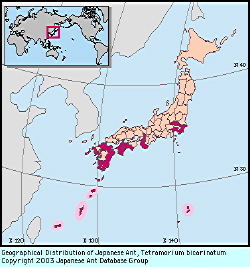
|
species
|
Tetramorium bicarinatum
|
 |
Japanese Name
|
Oo-shiwa-ari
|
Original Reference
|
|
Nylander, W. (1846) Additamentum adnotationum in monographiam formicarum borealium Europae. Acta Societatis Scientiarum Fennicae 2: 1041-1062.
|
Synonym
|
|
Formica bicarinata Nylander (Nylander, 1846) ,
Tetramorium guineense (Fabricius, 1793) sensu Mayr (Mayr, 1862) ,
Tetramorium bicarinatum Bolton (Bolton, 1977) ,
|
Description
|
|
Total length of workers around 3 mm. Body bicolorous: yellow to yellowish brown from head to postpetiole; gaster dark brown. Anterior margin of clypeus with a median notch. Antennae 12-segmented; scapes almost reaching posterior corners of head. Propodeal spines long and acute, curved upward. Body surfaces from head to postpetiole covered with irregular reticulate-rugosity; longitudinal rugae prominent on dorsum of head.
|
Remarks
|
|
The species is similar to T. nipponese, but distinguished by its shorter body hairs, dark-colored gaster, contrasting with the light yellowish remainder of the body, and higher posterior margin of the petiole in profile. T. bicarinatum is found in grassland and areas of bare coastal soil. It prefers more open and dryer situations than T. nipponense. Nests are found under stones and logs. The species epithet "bicarinatum" was reinstated from synonymy with Tetramorium guineense (Fabricius) by Bolton (1977). The name "T. guineense " was incorrectly used for this species for many years, but its type specimen has in fact proved to be a Pheidole. The origin of T. bicarinatum is considered to be South East Asia (Bolton, 1977), and it has been widely distributed to many parts of the world by human commerce.
|
|

Distribution
|
|
Honshu (Kanto District and southwards), Shikoku, Kyushu, Yaku I., Nansei Is, Ogasawara Is; Pan-tropical/subtropical (except for the Afrotropical region).
|
|
Editor
|
|
Original text by Kazuo Ogata and Keiichi Onoyama. English translation by Kazuo Ogata, edited by Robert W. Taylor.
|
|